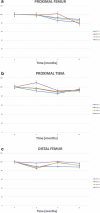Quantitative measurements of adaptive bone remodeling around the cemented Zimmer® segmental stem after tumor resection arthroplasty using dual-energy x-ray absorptiometry
- PMID: 34090413
- PMCID: PMC8180052
- DOI: 10.1186/s12891-021-04395-2
Quantitative measurements of adaptive bone remodeling around the cemented Zimmer® segmental stem after tumor resection arthroplasty using dual-energy x-ray absorptiometry
Abstract
Background: Limb salvage surgery (LSS) is the preferred method for treatment of patients with sarcomas and to a greater extent also to patients with metastatic bone disease. The aim of the present study was to evaluate the adaptive remodeling of the periprosthetic cortical bone after insertion of a tumor prosthesis with cemented stem.
Methods: A prospective study of 21 patients (F/M = 12/9), mean age 55 years (range 15-81) with metastatic bone disease (n = 9), sarcomas (n = 8) or aggressive benign tumors (n = 4) who underwent bone resection due to a tumor, and reconstruction with a tumor-prosthesis (Zimmer® Segmental 130 mm straight fluted cemented stem with trabecular metal (TM) collars) in the proximal femur (n = 10), distal femur (n = 9) or proximal tibia (n = 2). Measurements of bone mineral density (BMD) (g/cm2) were done postoperatively and after 3, 6, and 12 months using dual-energy X-ray absorptiometry. BMD was measured in 4 regions of interest around the cemented stem and in one region of interest 1 cm proximal from the ankle joint of the affected limb and measurement of the contralateral ankle was used as reference. Repeated measures ANOVA and students paired t-test was used to evaluate BMD changes over time.
Results: At 1-year follow-up, BMD decreased compared to baseline in all four regions of interest with a statistically significant bone loss of 8-15%. The bone loss was most pronounced (14-15%) in the 2 regions of interest closest to the trabecular metal (TM) collar and lowest (8%) adjacent to the tip of the stem.
Conclusion: After 1 year the decrease in bone mineral density of the ankle on the affected limb was 9% and the contralateral ankle was close to baseline, thus suggesting that the periprosthetic bone mineral density changes during follow-up, mainly are caused by stress shielding and immobilization.
Trial registration: The study was approved by the Scientific Ethical Committee of the Capital Region of Denmark (J. No. H-2-2014-105) and the Danish Data Protection Agency (J. No.: 2012-58-00004 ).
Keywords: Bone mass density; Dual-energy X-ray absorptiometry; Stress shielding; Tumor prostheses.
Conflict of interest statement
The authors declare that they have no competing interests.
Figures




References
MeSH terms
LinkOut - more resources
Full Text Sources
Medical

